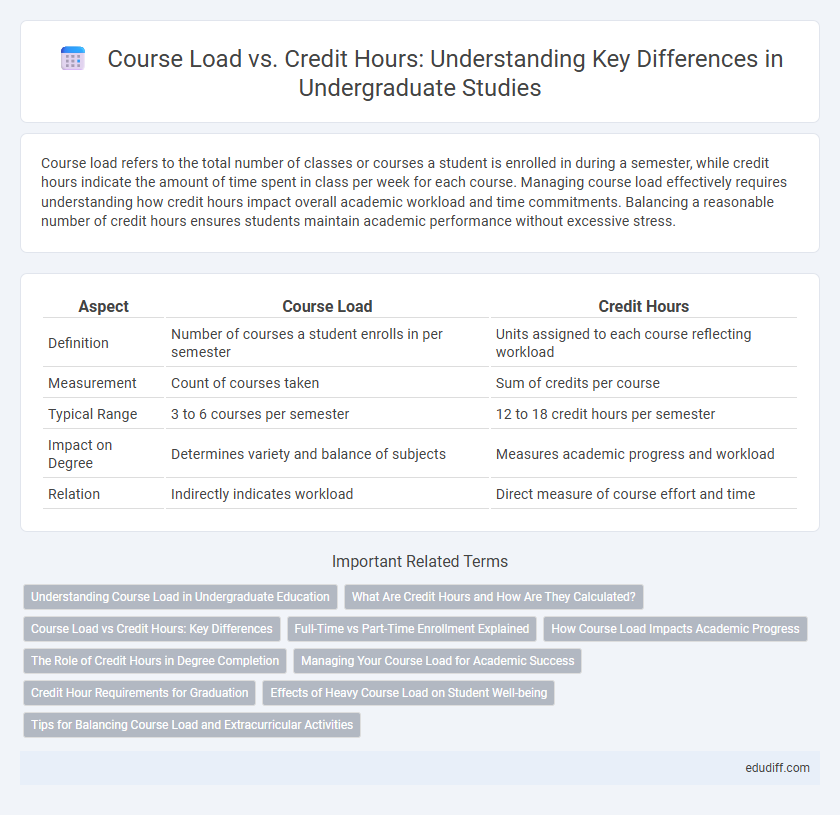Course load refers to the total number of classes or courses a student is enrolled in during a semester, while credit hours indicate the amount of time spent in class per week for each course. Managing course load effectively requires understanding how credit hours impact overall academic workload and time commitments. Balancing a reasonable number of credit hours ensures students maintain academic performance without excessive stress.
Table of Comparison
| Aspect | Course Load | Credit Hours |
|---|---|---|
| Definition | Number of courses a student enrolls in per semester | Units assigned to each course reflecting workload |
| Measurement | Count of courses taken | Sum of credits per course |
| Typical Range | 3 to 6 courses per semester | 12 to 18 credit hours per semester |
| Impact on Degree | Determines variety and balance of subjects | Measures academic progress and workload |
| Relation | Indirectly indicates workload | Direct measure of course effort and time |
Understanding Course Load in Undergraduate Education
Course load in undergraduate education refers to the total number of credit hours a student enrolls in during a semester, influencing academic workload and time management. Typically, full-time students undertake 12 to 18 credit hours per term, balancing lectures, assignments, and exams. Understanding course load helps optimize academic performance and prevent burnout by aligning study commitments with personal capacity.
What Are Credit Hours and How Are They Calculated?
Credit hours represent the amount of academic credit a student receives for completing a course, typically reflecting the number of hours spent in class per week during a term; for example, a three-credit course usually means three hours of weekly classroom instruction over a semester. Calculation of credit hours is based on classroom time plus expected outside work, where one credit hour generally equates to one hour of class and two hours of homework each week. The total credit hours accumulated determine a student's course load and progress toward degree completion in undergraduate programs.
Course Load vs Credit Hours: Key Differences
Course load refers to the number of courses a student takes during a semester, while credit hours represent the total hours of instruction or workload assigned to each course. Credit hours quantify the academic weight of each course, typically ranging from 1 to 4 hours per course, influencing the student's overall workload and graduation timeline. Understanding the distinction between course load and credit hours helps students manage their academic commitments effectively and meet degree requirements.
Full-Time vs Part-Time Enrollment Explained
Full-time undergraduate enrollment typically requires a minimum of 12 credit hours per semester, while part-time students enroll in fewer than 12 credit hours, affecting their course load intensity and academic pace. Full-time students often balance 15-18 credit hours, enabling graduation within the standard four-year timeline, whereas part-time students may extend their studies due to reduced semester course loads. Credit hours quantify the amount of classroom time per week, dictating whether a student's course load qualifies as full-time or part-time enrollment status.
How Course Load Impacts Academic Progress
Course load, defined by the number of courses taken per semester, directly influences the accumulation of credit hours necessary for degree completion. A heavier course load can accelerate academic progress by increasing the total credit hours earned each term, while a lighter load may extend the time needed to graduate. Balancing course load with individual capacity is essential to maintaining academic performance and timely progression toward degree requirements.
The Role of Credit Hours in Degree Completion
Credit hours quantify the amount of academic work completed, serving as a key metric in tracking progress toward degree completion. Each course is assigned a specific number of credit hours, reflecting the expected time commitment and learning outcomes required. Accumulating the requisite credit hours ensures students meet graduation requirements and are eligible for degree conferral.
Managing Your Course Load for Academic Success
Balancing your course load with credit hours is crucial for academic success, as taking too many credits can lead to burnout while too few may extend graduation time. Universities typically recommend a full-time student to enroll in 12 to 15 credit hours per semester, allowing for manageable study time and extracurricular involvement. Effective time management and realistic course selection based on credit hours directly impact GPA and overall student well-being.
Credit Hour Requirements for Graduation
Credit hour requirements for graduation typically range from 120 to 130 credit hours for undergraduate programs, ensuring students complete a designated amount of coursework to demonstrate mastery and meet academic standards. Each course's credit hours quantify the expected time commitment, usually translating into weekly classroom hours and estimated outside study. Universities carefully structure these requirements to balance depth and breadth in education while maintaining timely progression toward degree completion.
Effects of Heavy Course Load on Student Well-being
A heavy course load, often exceeding 15 credit hours per semester for undergraduates, can significantly impact student well-being by increasing stress levels and reducing time available for rest and social activities. Research indicates that students carrying 18 or more credit hours report higher instances of anxiety and academic burnout compared to peers with lighter schedules. Balancing credit hours with personal health is essential to maintain academic performance and overall mental health.
Tips for Balancing Course Load and Extracurricular Activities
Balancing course load and extracurricular activities requires prioritizing time management by allocating specific hours for studying and participation in clubs or sports. Effective planning involves assessing credit hours, as higher credit courses demand more study time, so moderating course load each semester can prevent burnout. Utilizing campus resources such as academic advisors and time-management workshops supports maintaining an equilibrium between academic responsibilities and extracurricular commitments.
Course Load vs Credit Hours Infographic

 edudiff.com
edudiff.com